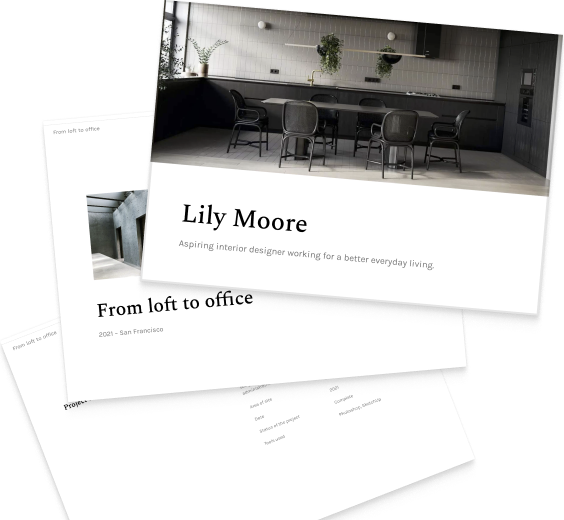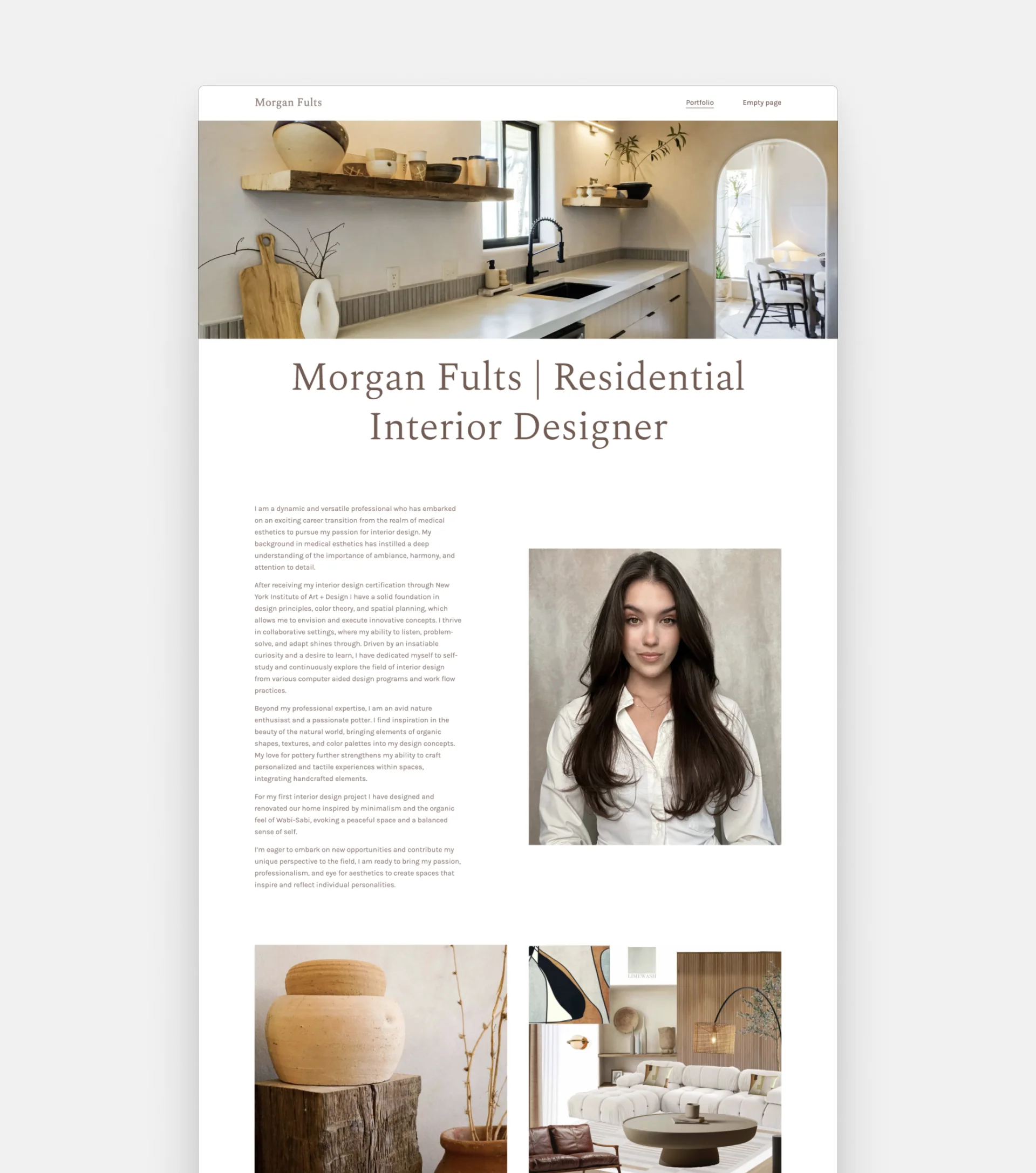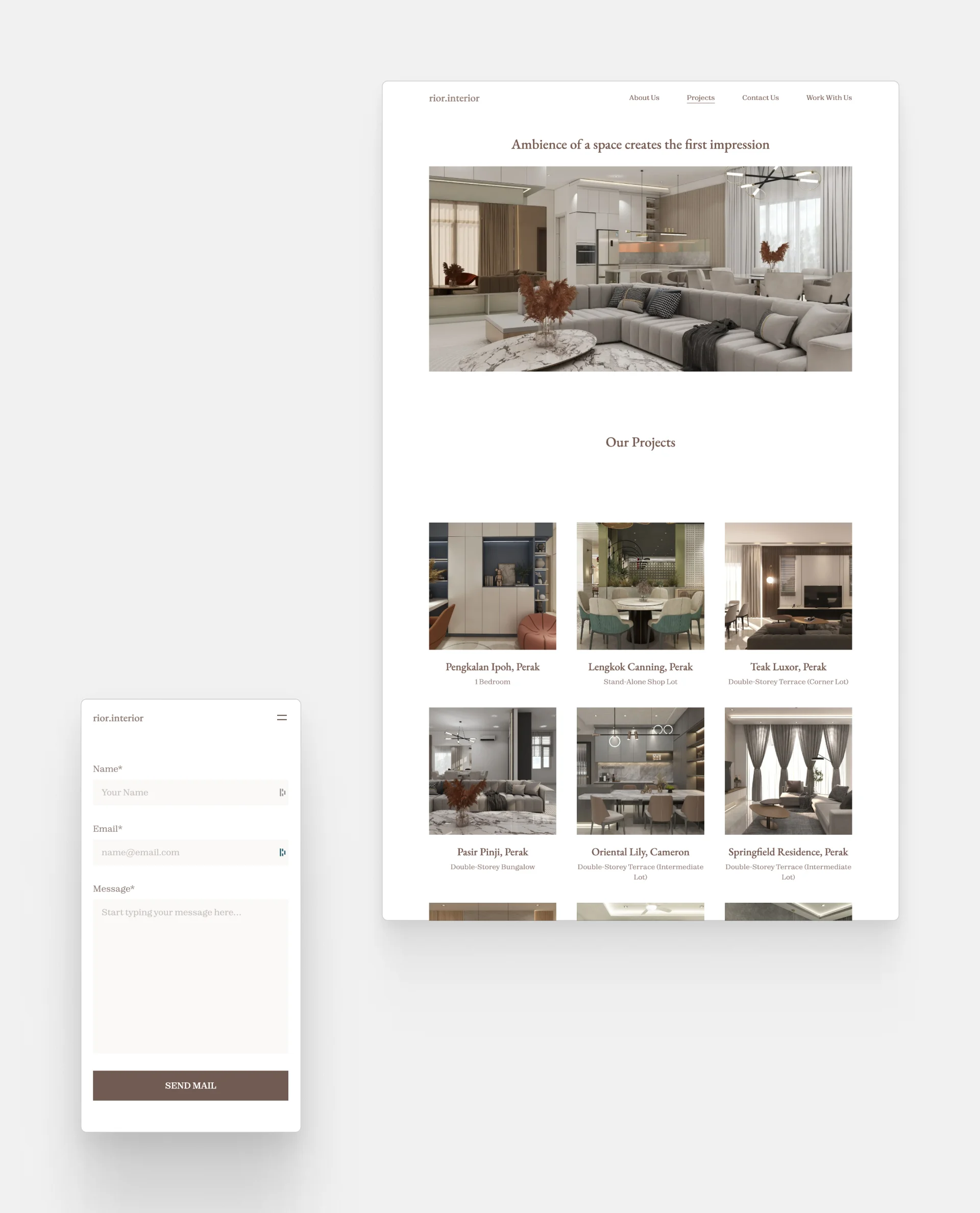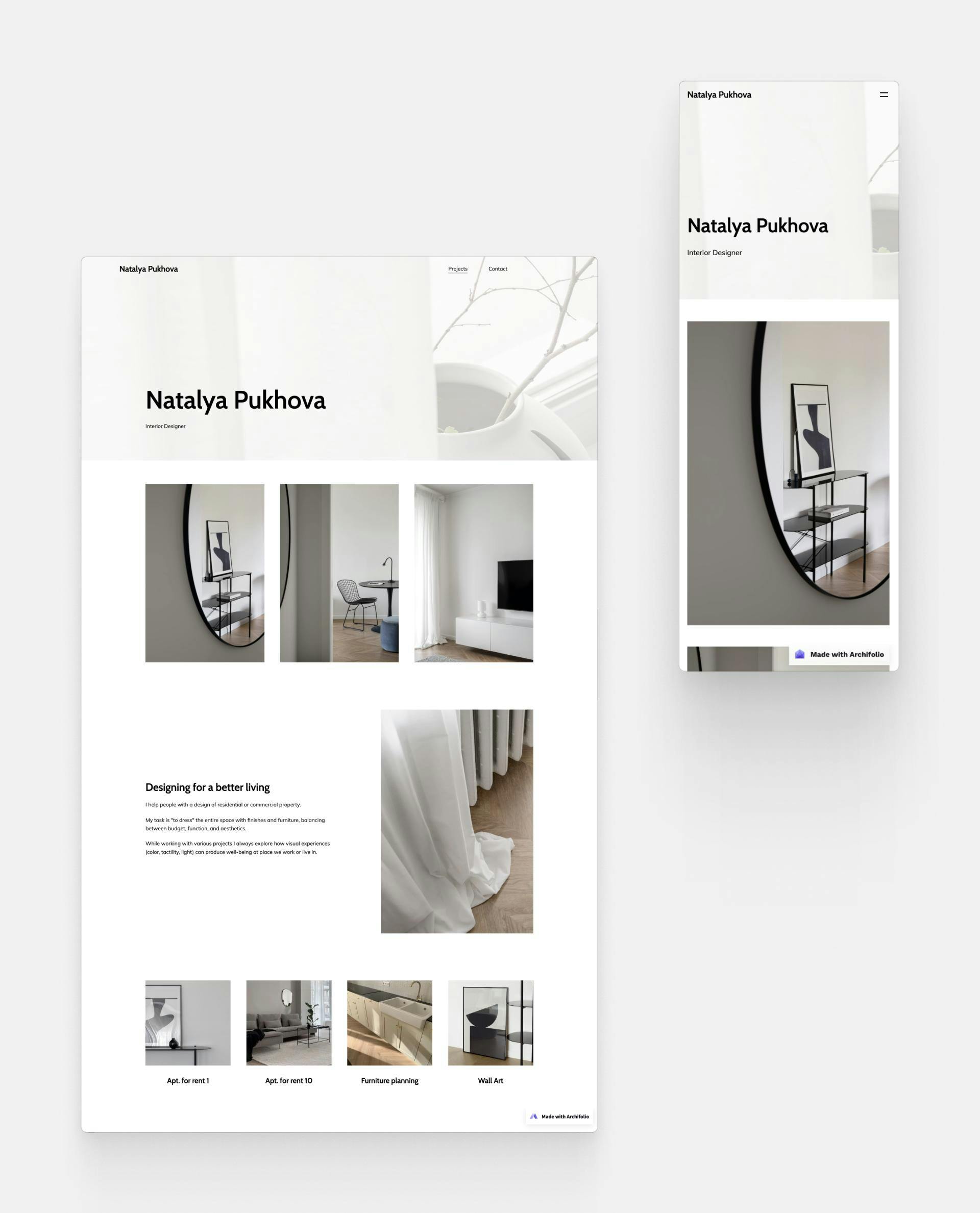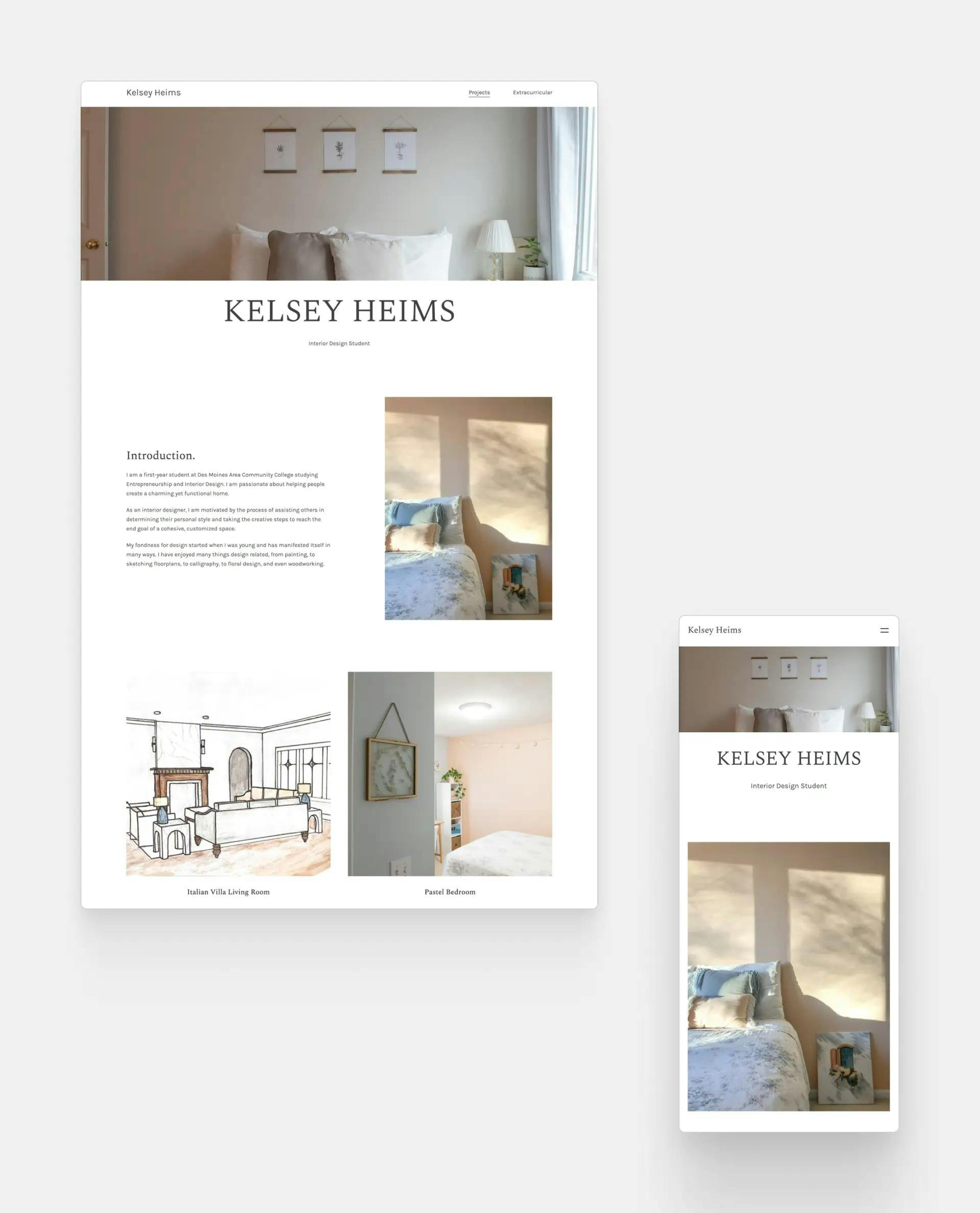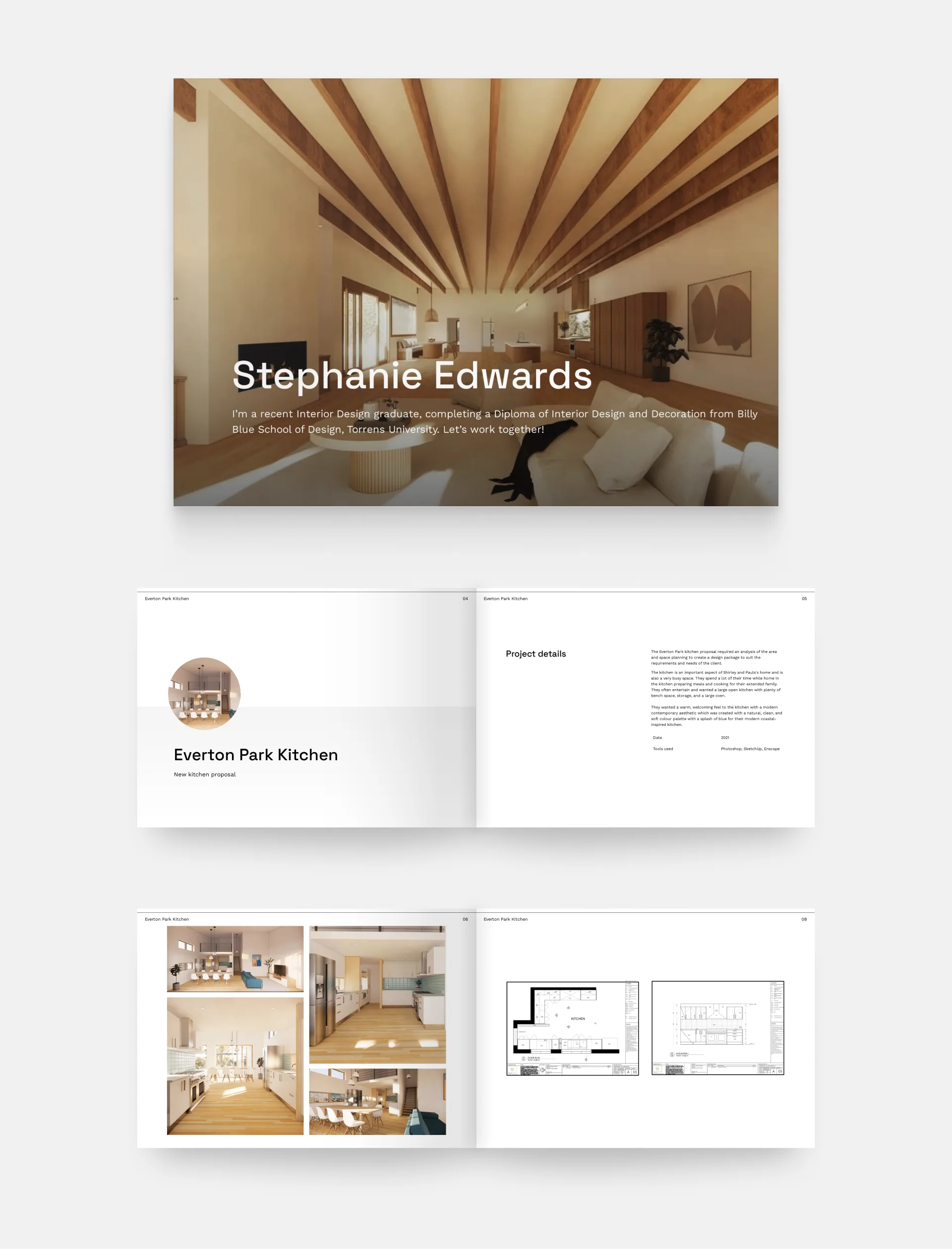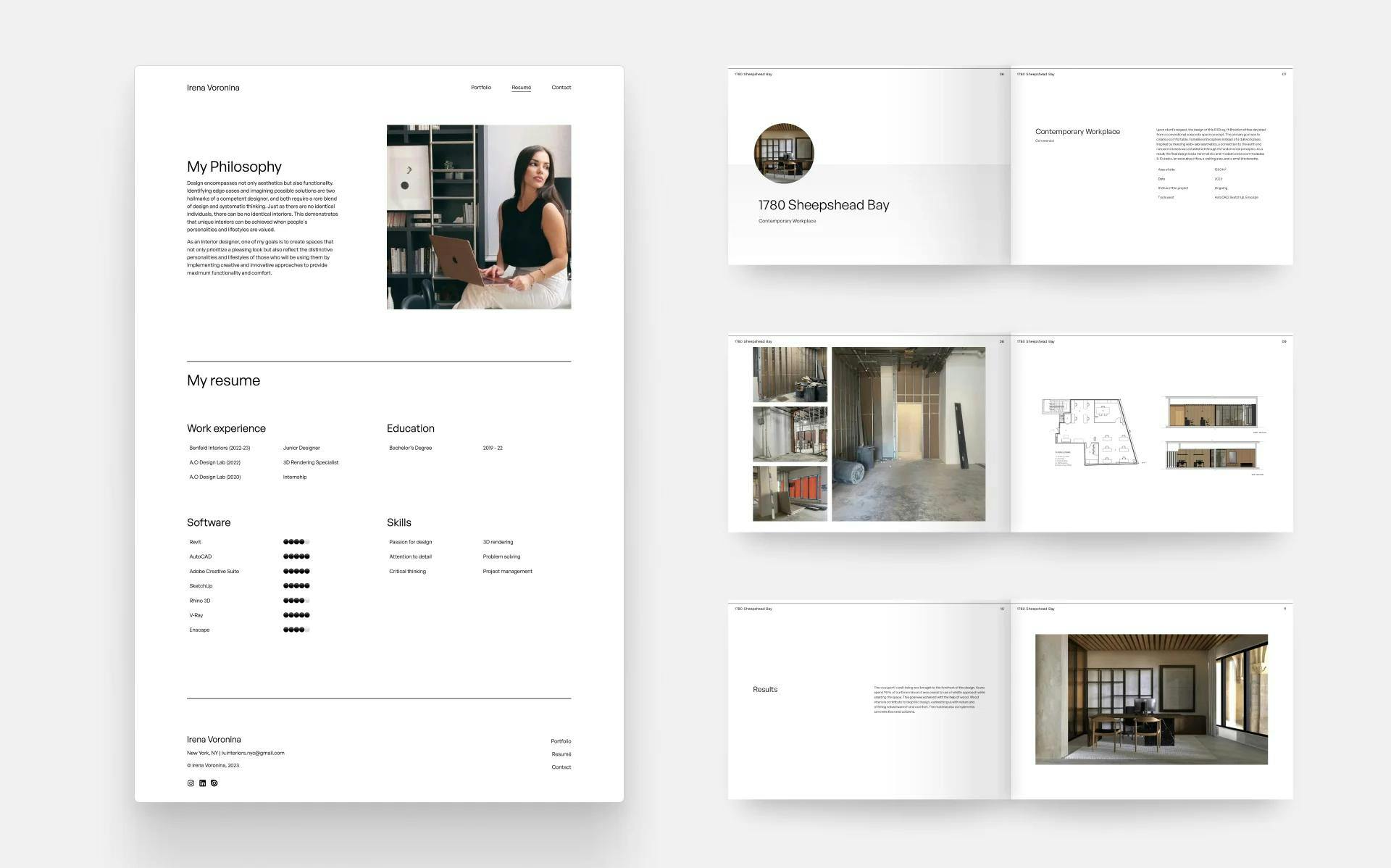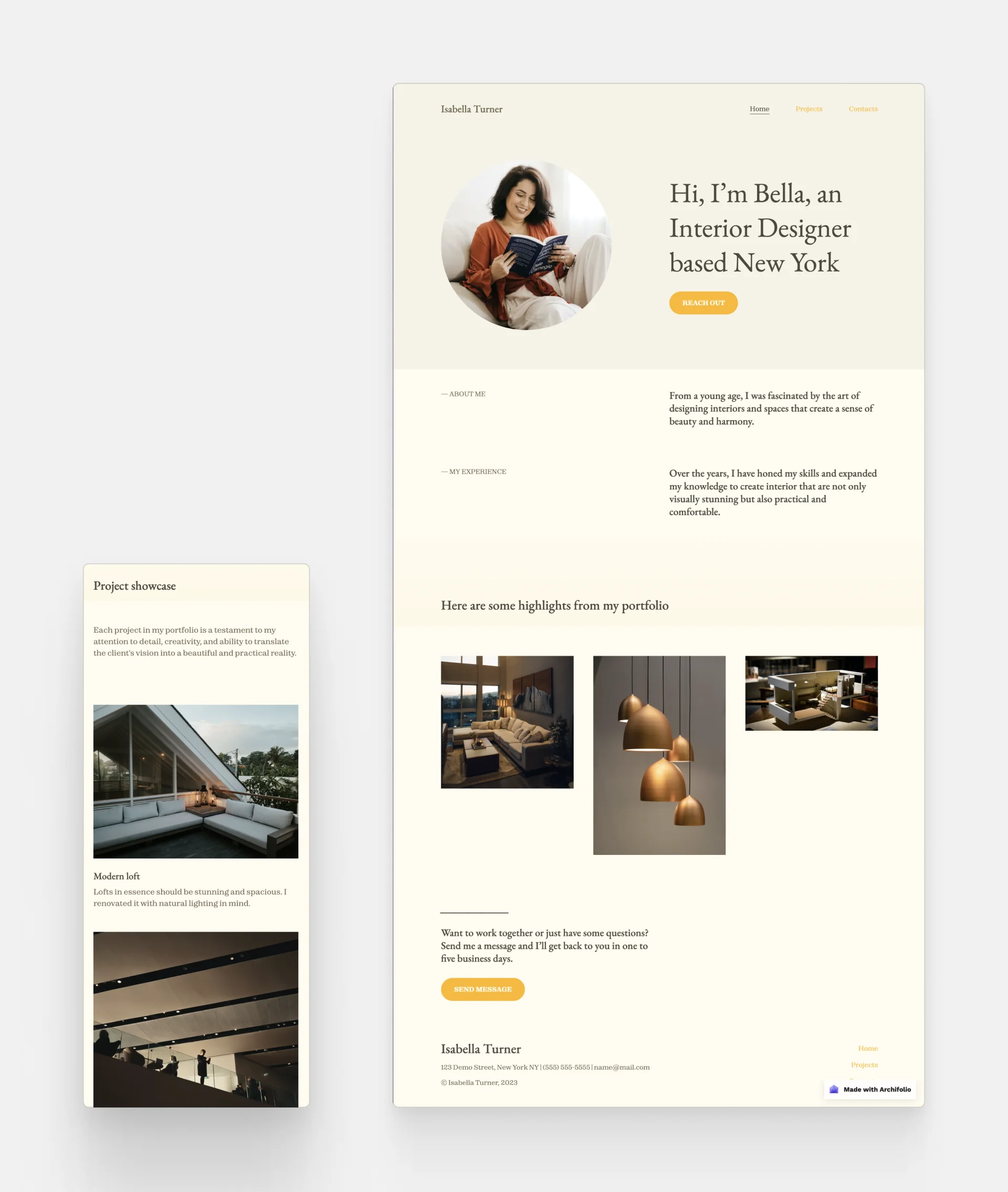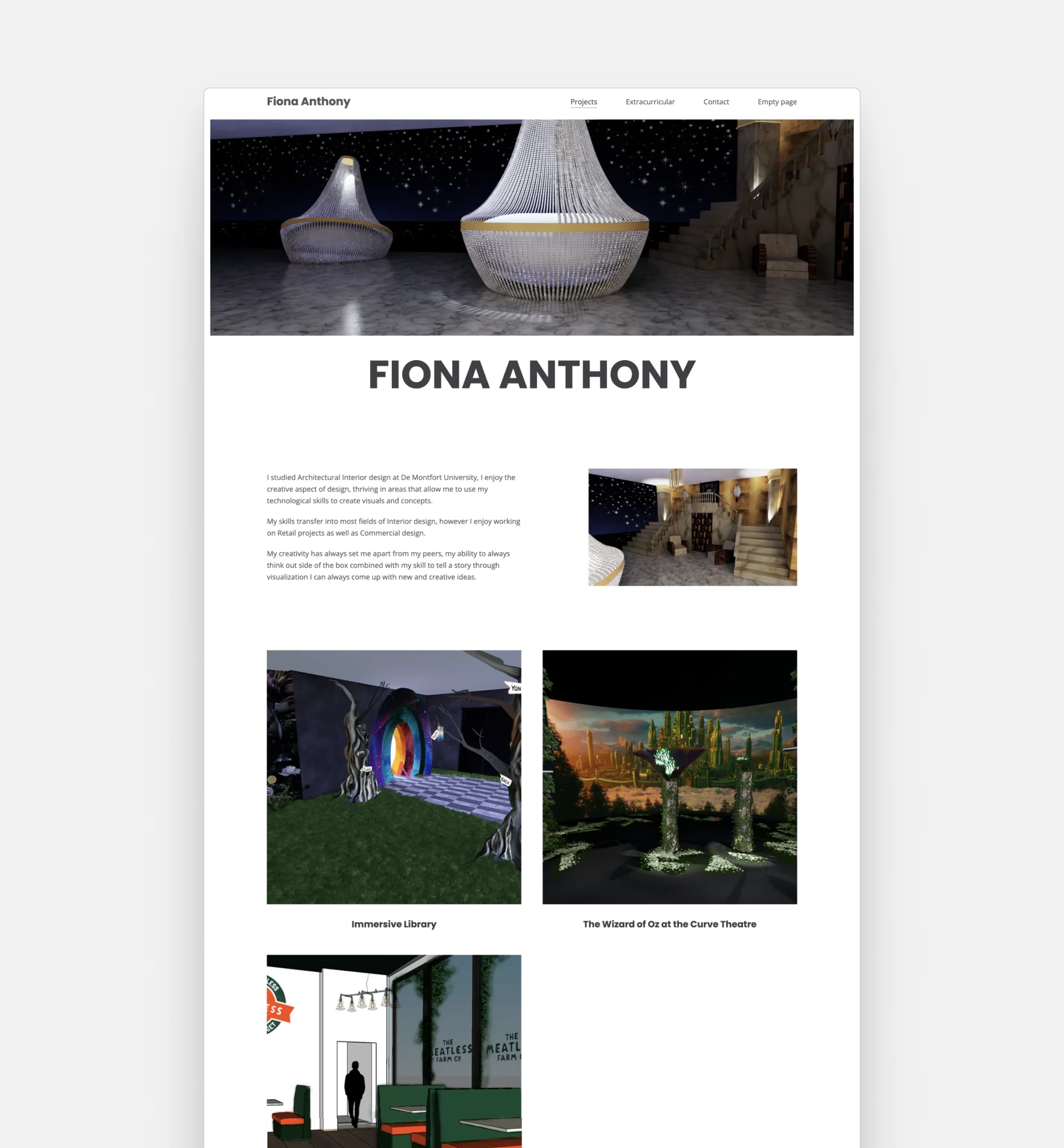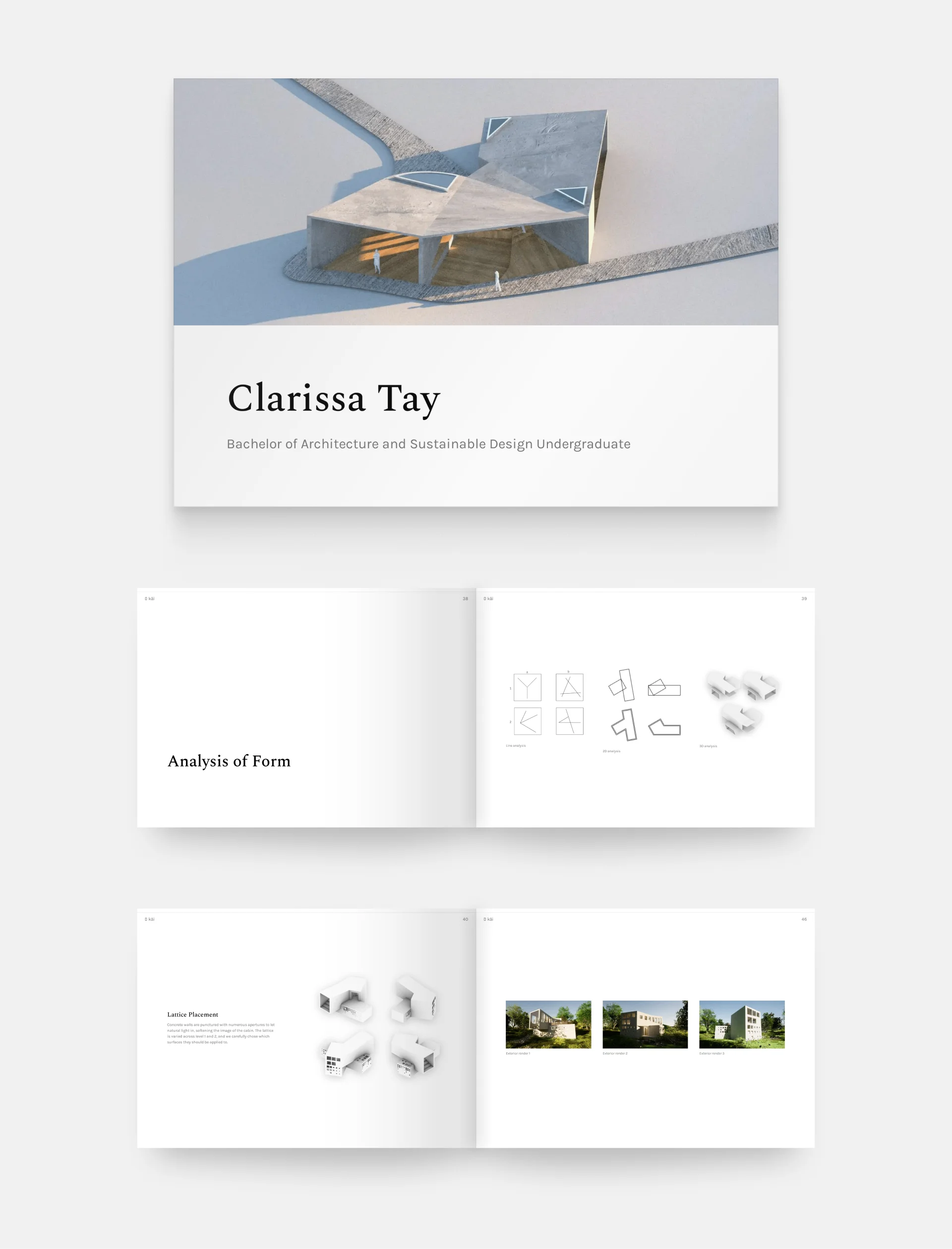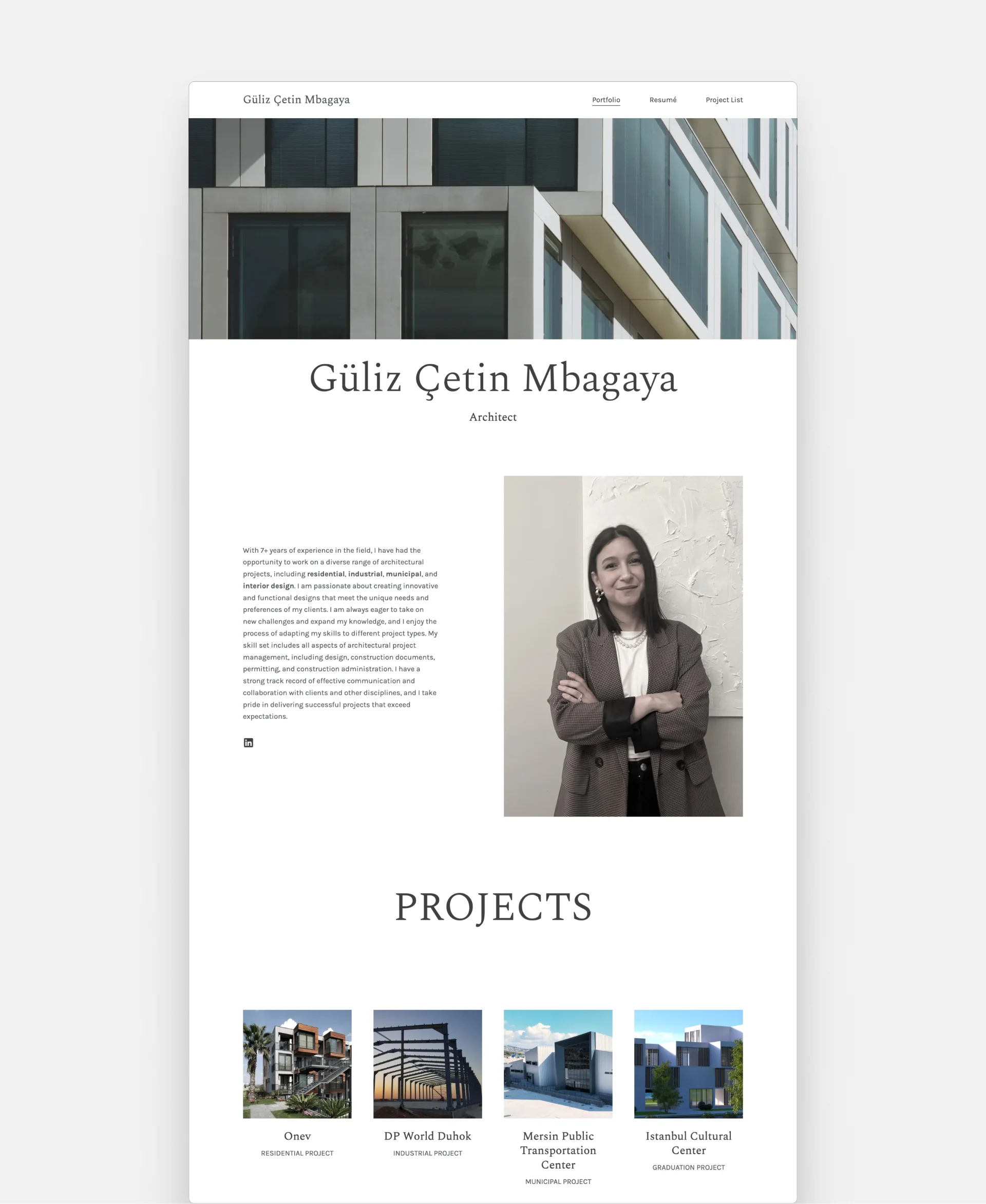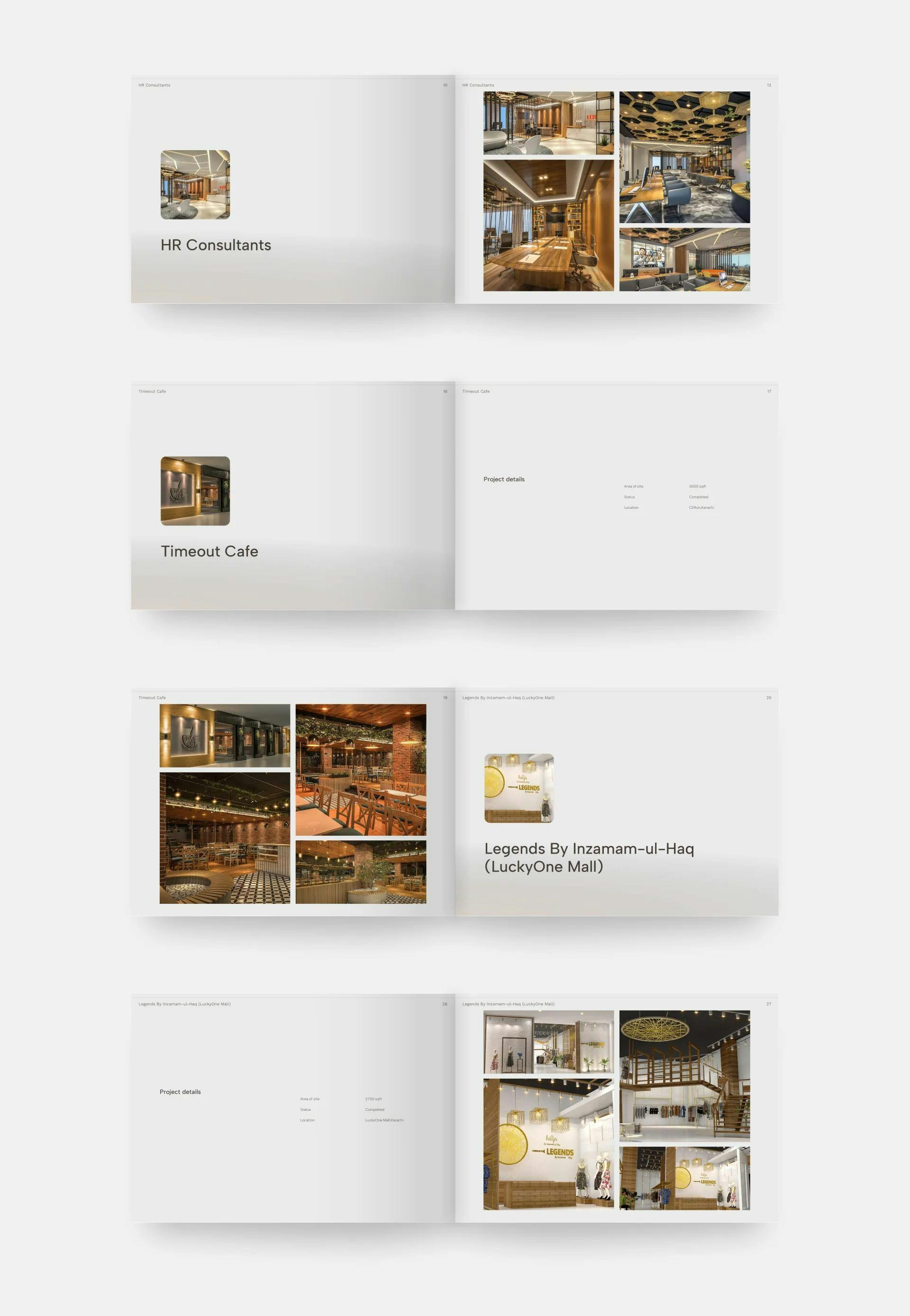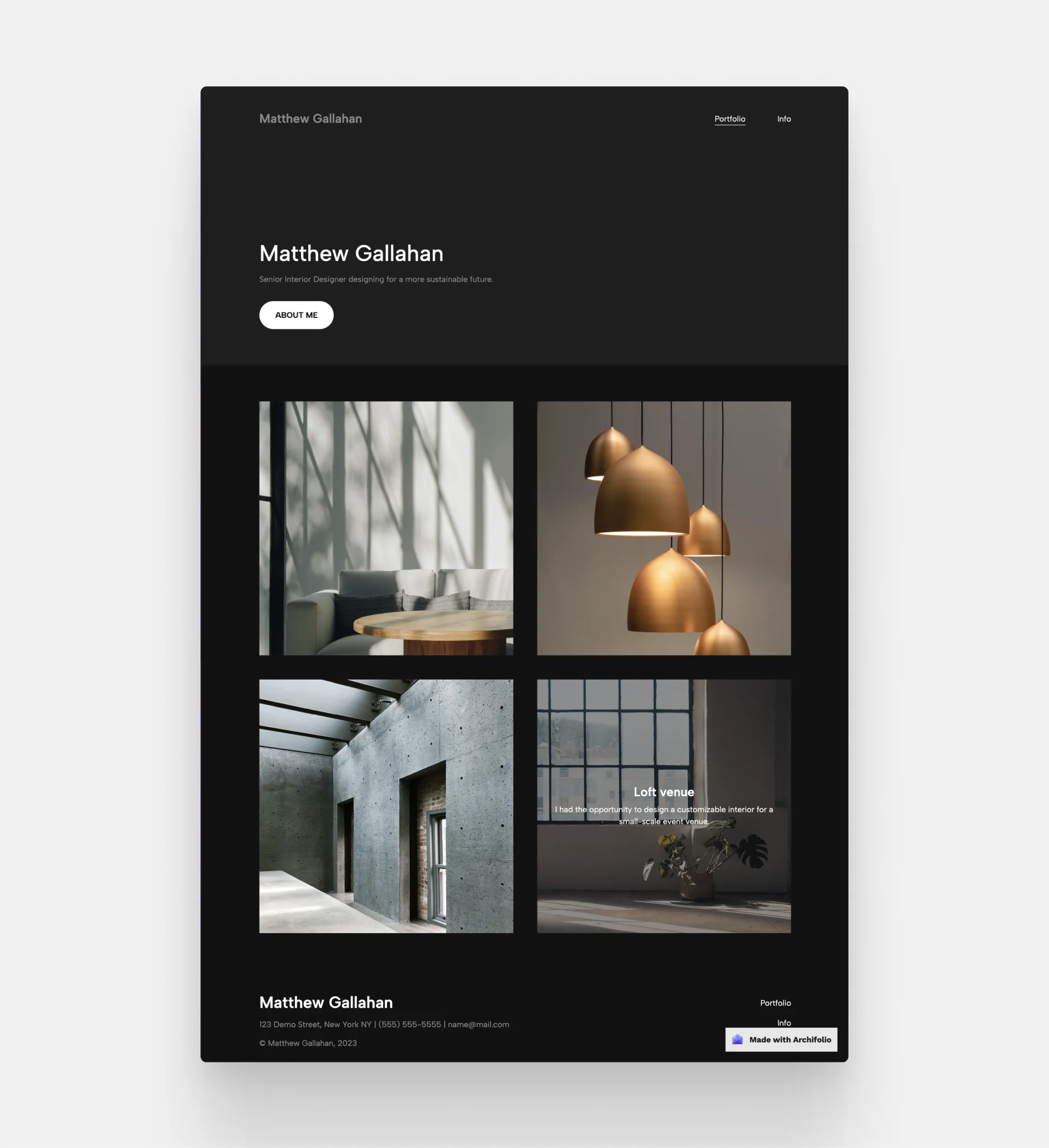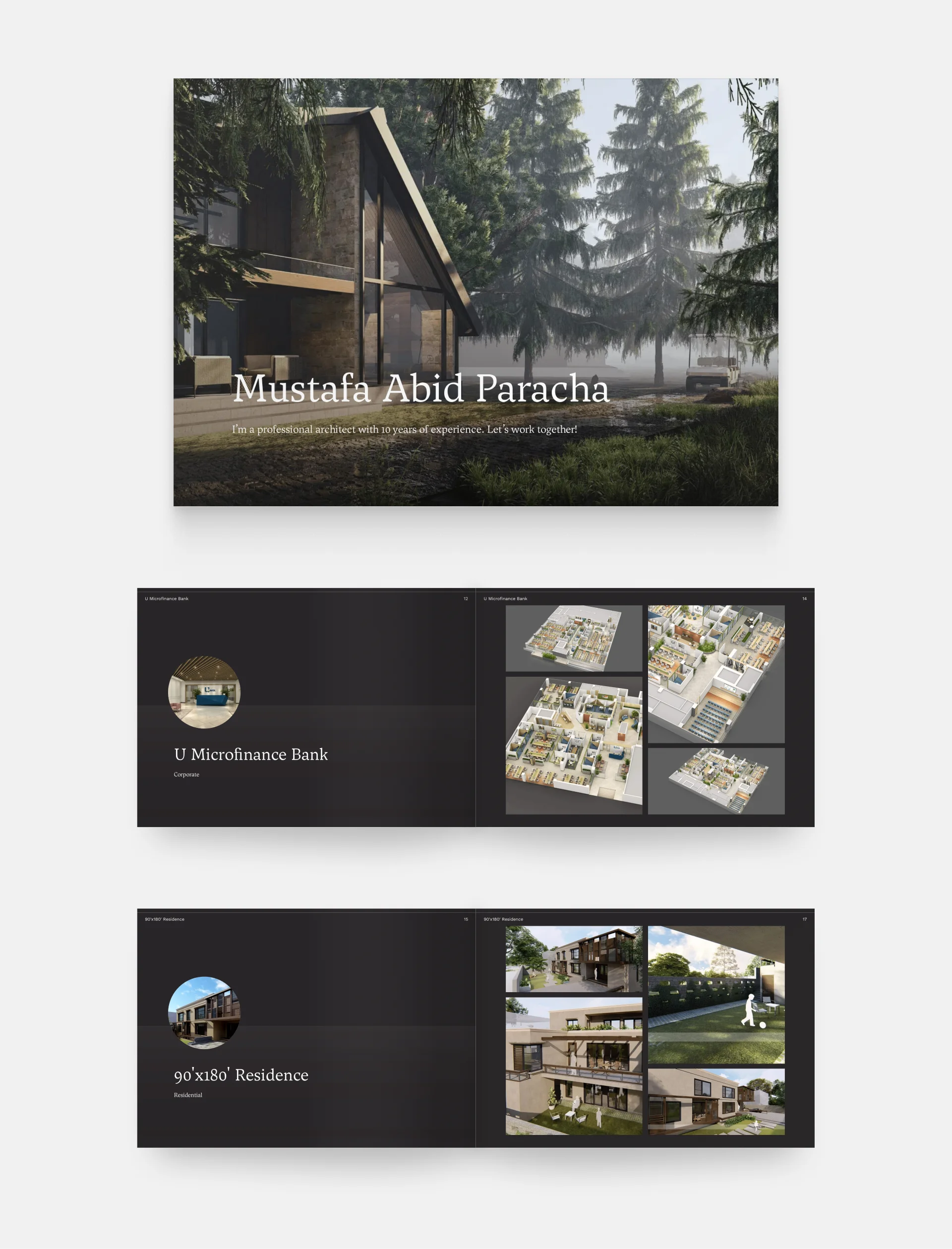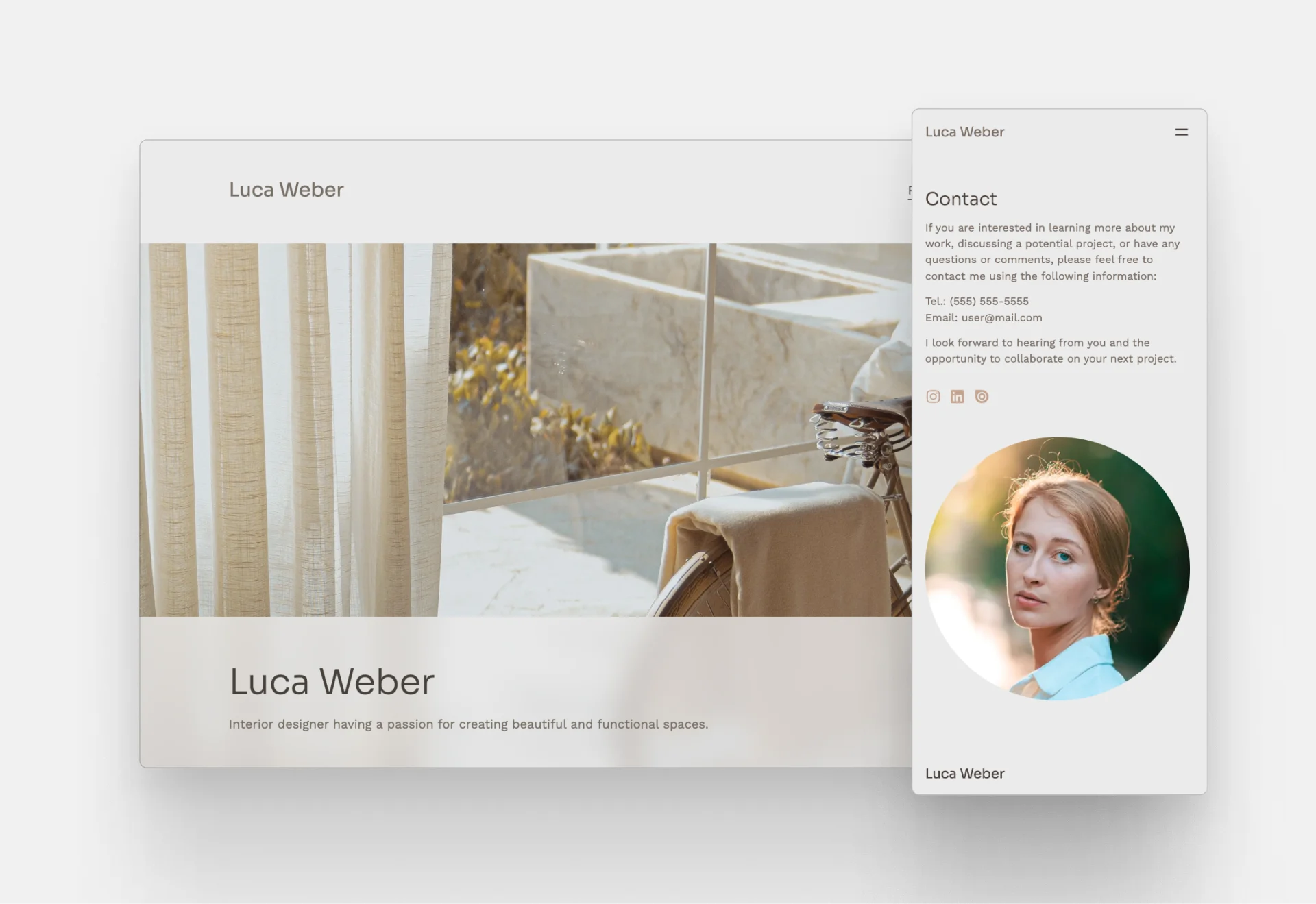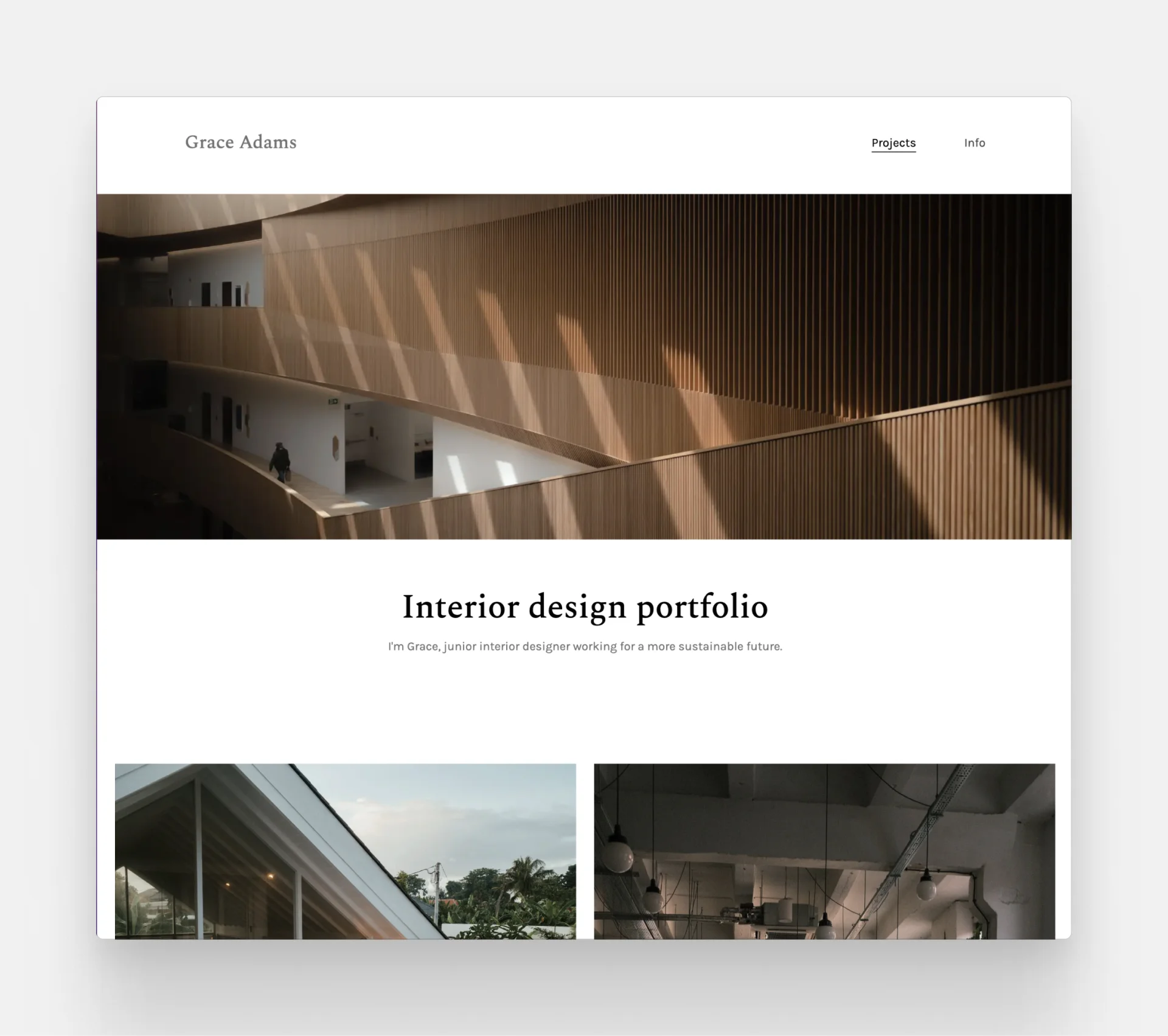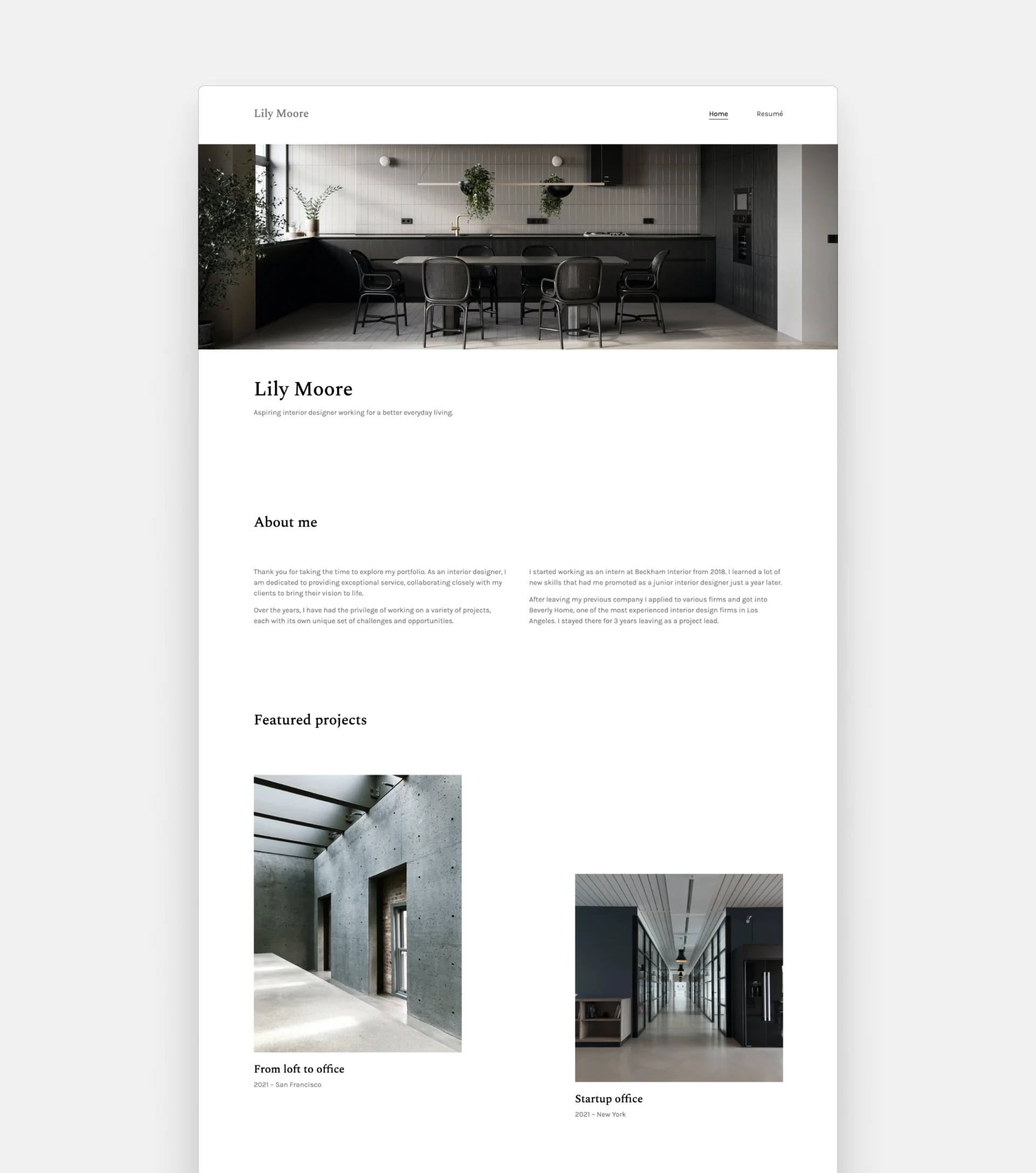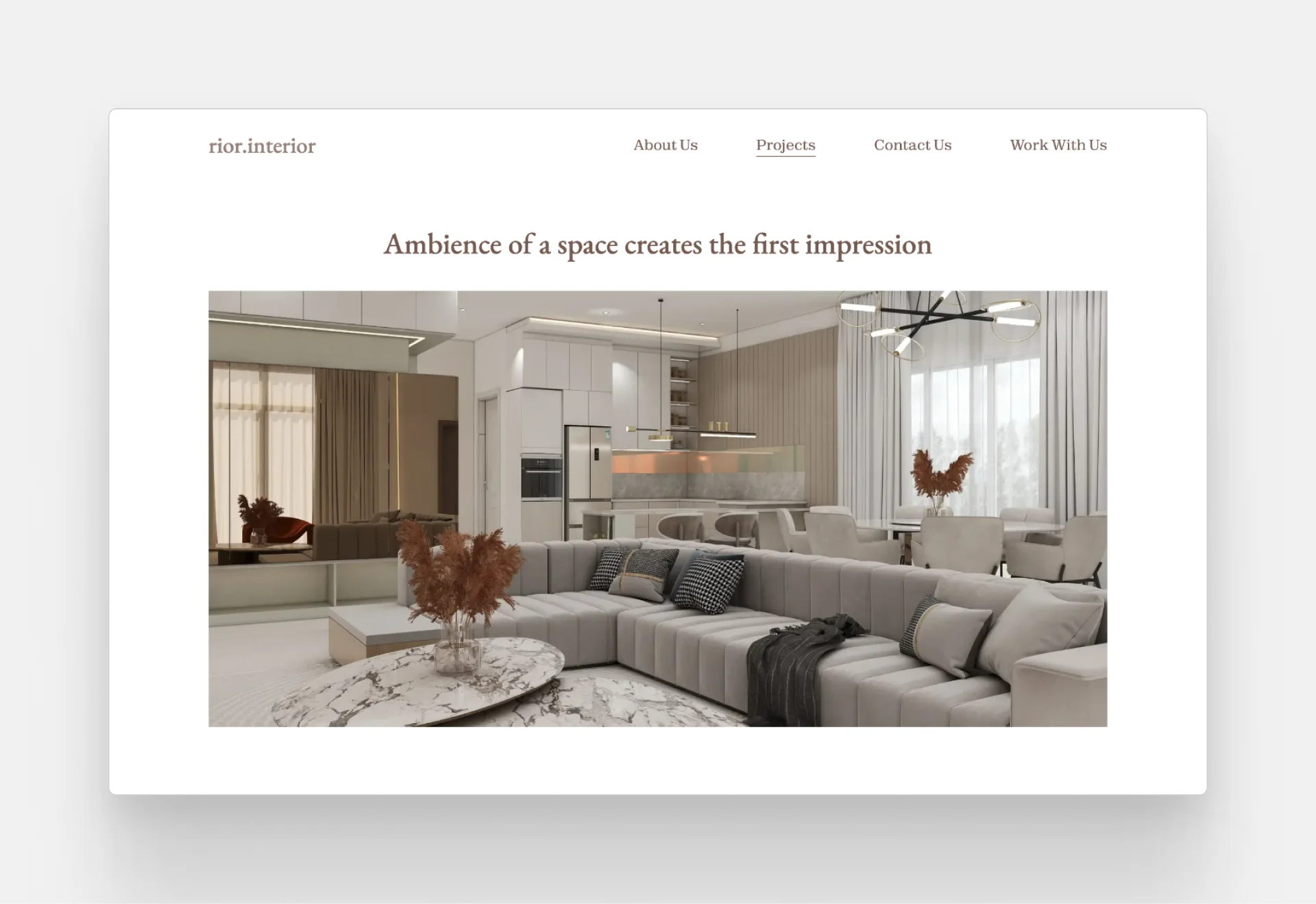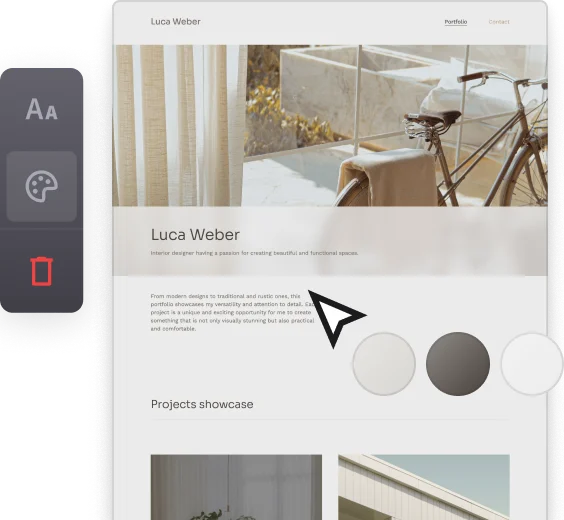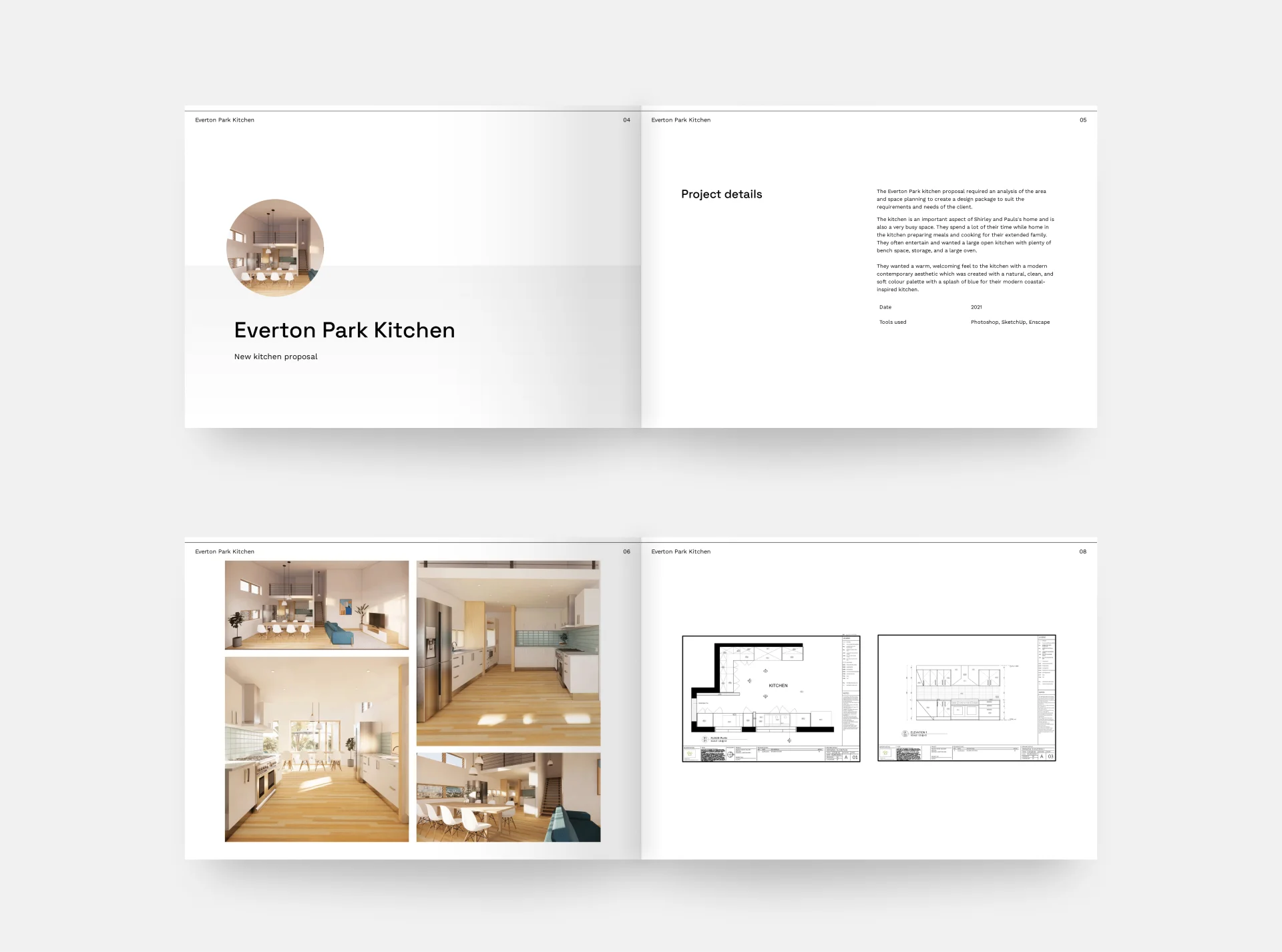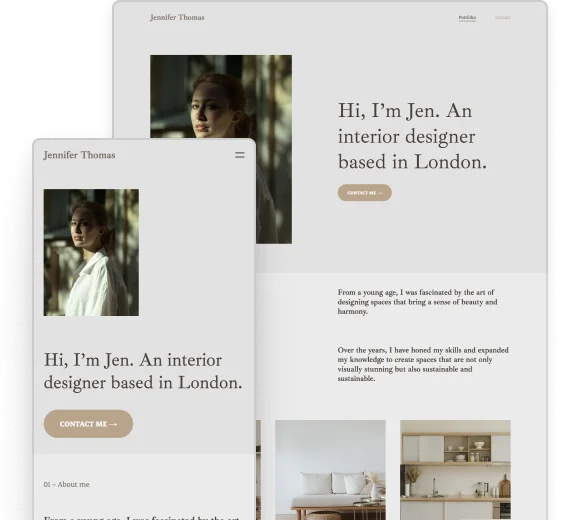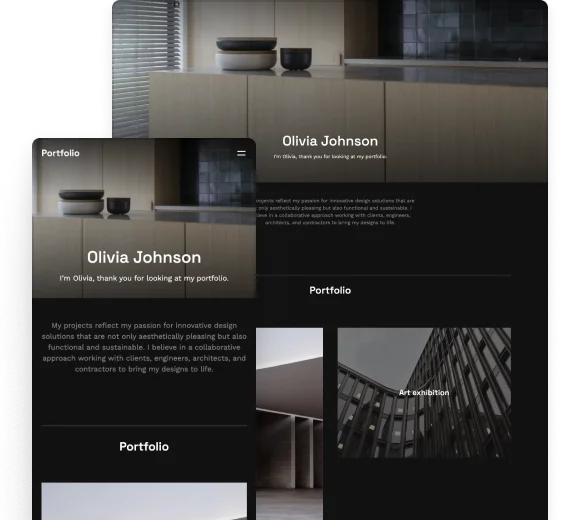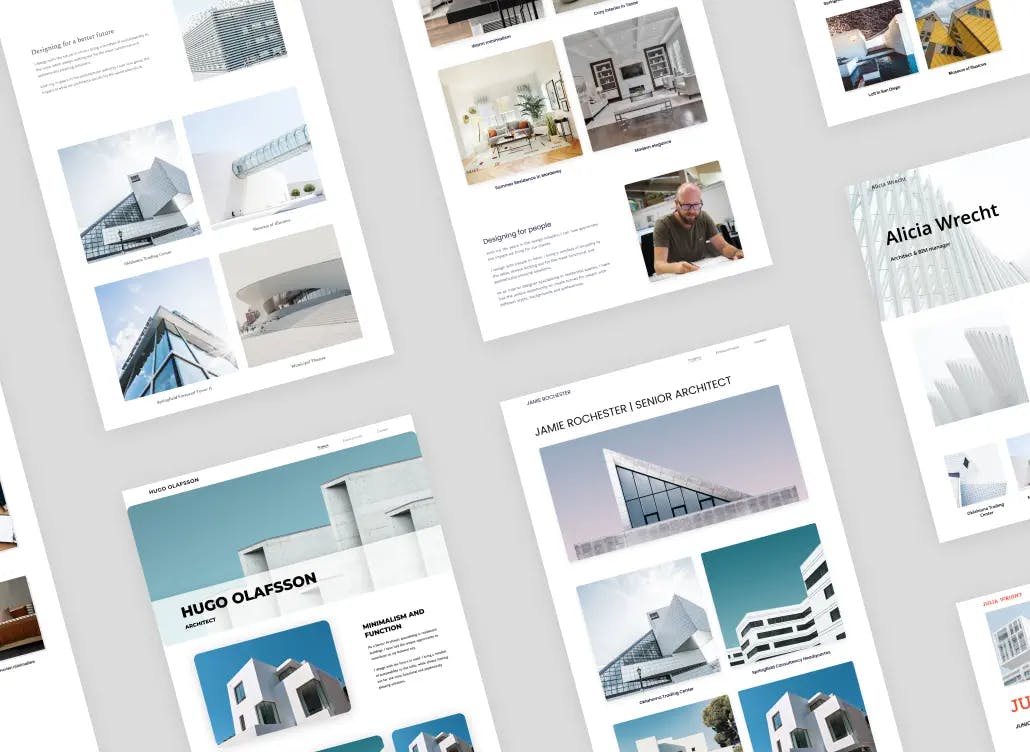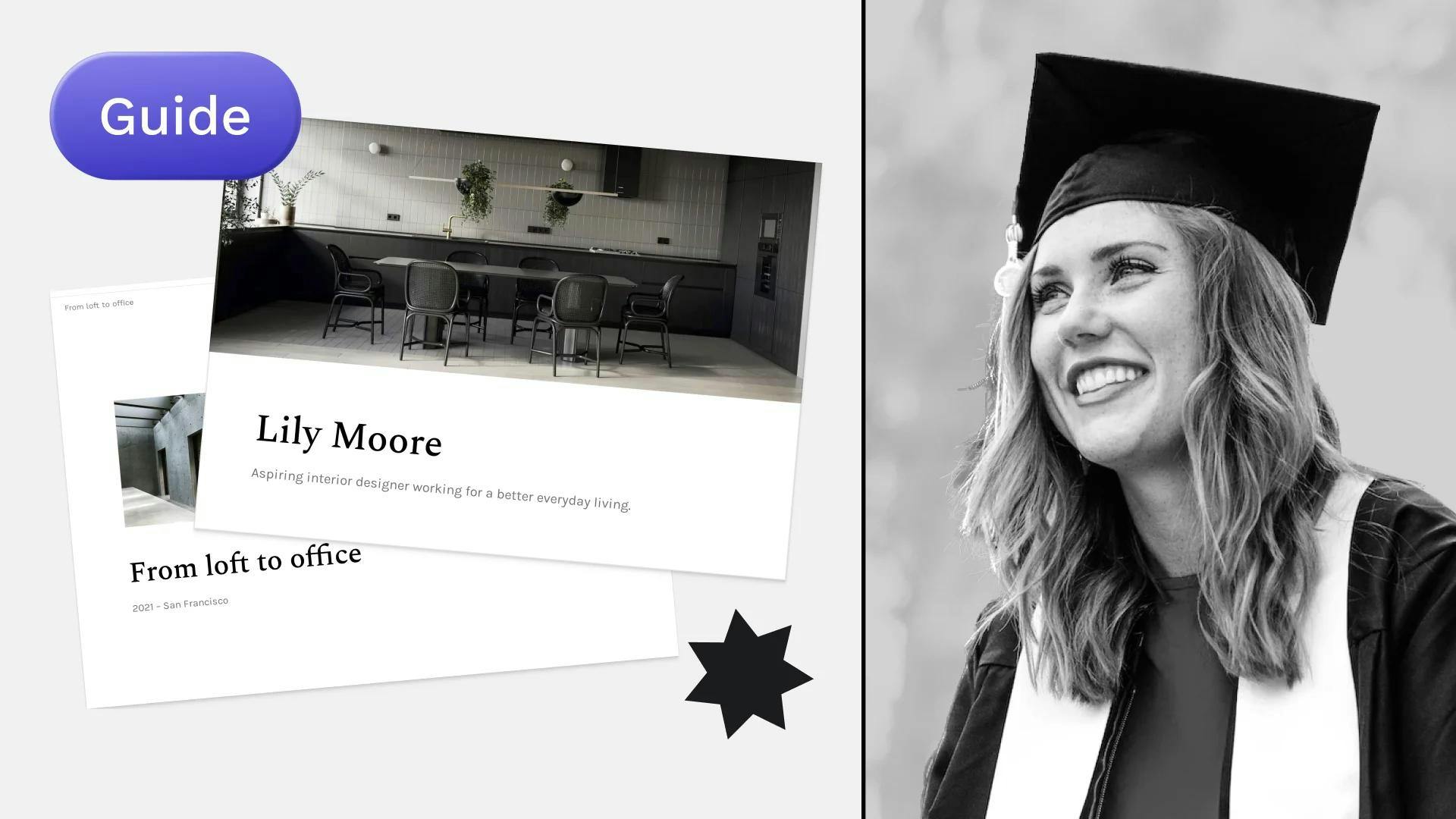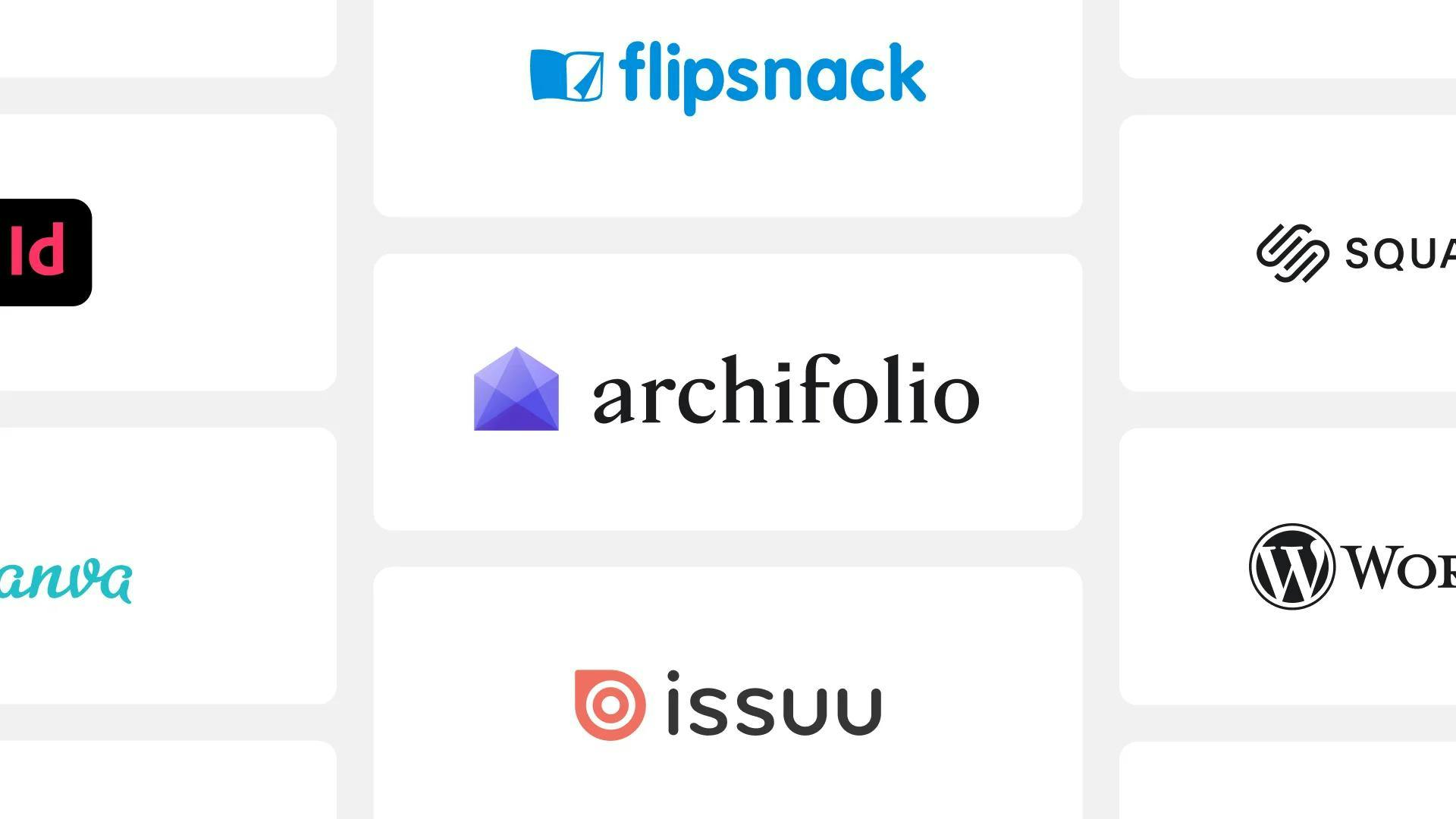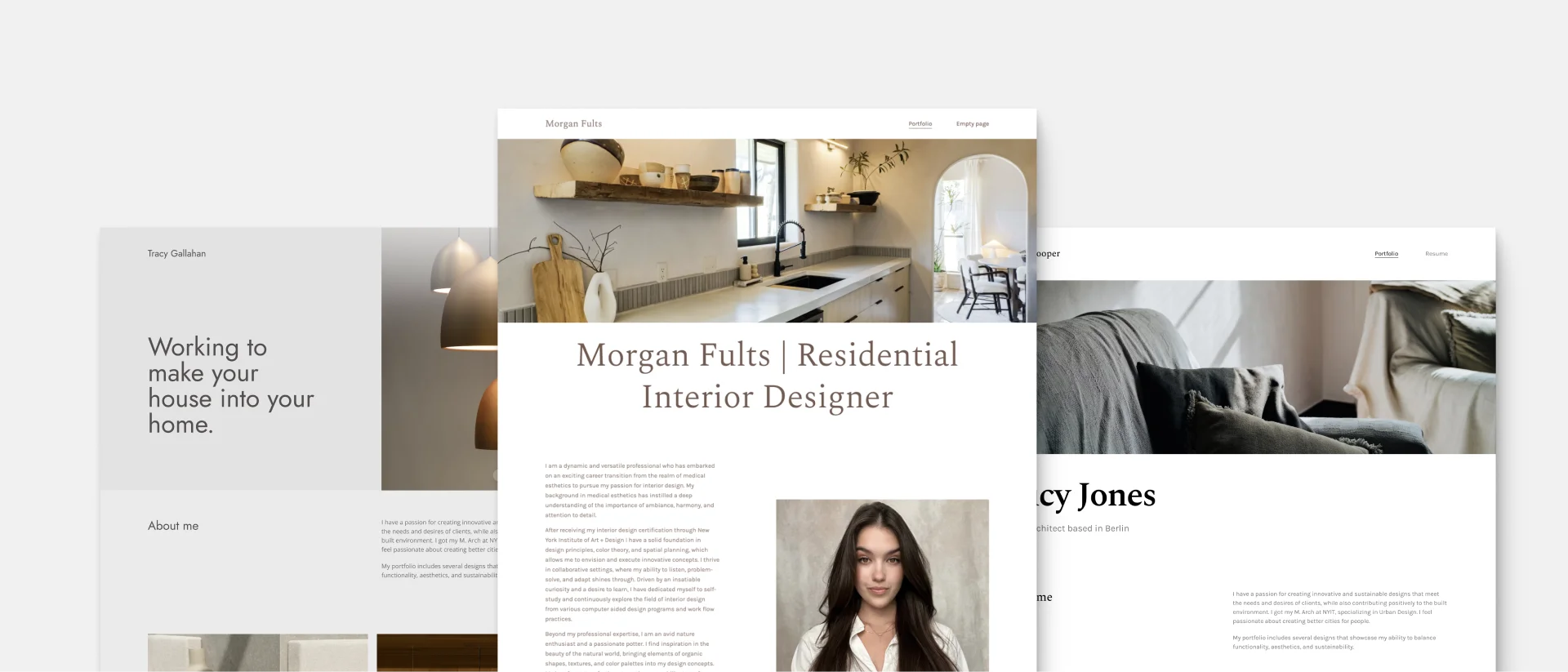
16+ Interior Design Portfolio Examples & 4 Easy Steps to Create Yours
A resume alone is never enough in any creative field. Therefore, creating a good interior design portfolio will get you ahead, but failing to do so might cause you a lot of frustration.
In this article, you’ll find some of the best examples to get you inspired. Then we’ll walk you through creating your own stunning portfolio in 4 easy steps. No matter if you are planning to go to college, seeking employment, or starting freelance work, this article is for you.
16 interior design portfolio examples for inspiration
1. Morgan Fults
Morgan Fults' interior design website
Morgan is a residential interior designer with a gift for creating cozy interiors and stunning pottery. She has a keen eye for detail when it comes to her projects and her portfolio as well. We love how her thumbnails work so well together, and how the style and color of her portfolio matches her images.
Template: Archifolio's Agora template
2. Rior Interior
Rior Interior's portfolio website
When you visit Rior Interior's website, you'll immediately see the expertise that they bring to their projects. They speak the language of their ideal clients, they include a lot of excellent render-heavy project pages, which conveys their unique style. They added a contact form, which makes it easy for clients to get in touch with the designers.
Template: Archifolio's Palazzo template
3. Natalya Pukhova
Natalya Pukhova's portfolio created with Archifolio
Natalya's portfolio is so crisp and clean that it immediately amazed us. Her modern scandinavian style shines through her portfolio with the light colors with earthy tones. Spot-on! She created a very visual interior design portfolio, with professional images and limited amounts of text.
Template: Archifolio's Museum template
4. Kelsey Heims
Kelsey created her beautiful portfolio with Archifolio
Kelsey's portfolio is a perfect example of a stunning interior design student portfolio. She doesn't have much experience to showcase, so she got creative. She included two stunning bedroom decorating projects and some hand renderings. What a perfect way to showcase your skills and get your hands dirty as a student.
Template: Archifolio's Agora template
5. Stephenie Edwards
Stephanie Edwards' PDF portfolio created with Archifolio
Stephanie is a freshly graduated interior designer based in Australia. The portfolio cover she created with her modern farmhouse project is stunning in itself, yet our favorite part is the way she structured her project pages. She has some beautiful renders, but they are in perfect harmony with her technical images.
Template: Archifolio's Museum template
6. Irena Voronina
Irena Voronina's portfolio
Template: Archifolio's Museum template
7. Isabella Turner
A mock project created with Archifolio
This site is bright, airy, and eye-catching. The projects are all on different pages, but there are sneak peeks in a gallery section right away on the home page. This is a website created by the designers at Archifolio.
Template: Archifolio's Modular template
8. Fiona Anthony
Fiona Anthony's interior design portfolio
Template: Archifolio's Agora template
9. Clarissa Tay
Clarissa Tay's portfolio
Template: Archifolio's Agora template
10. Güliz Çetin Mbagaya
Güliz Çetin Mbagaya's portfolio
Template: Archifolio's Agora template
11. Fatima Israr Studio
Fatima Israr Studio's portfolio
Template: Archifolio's Palazzo template
12. Matthew Gallahan
Mock project by Archifolio
Template: Archifolio's Modular template
13. Mustafa Abid Paracha
Mustafa Abid Paracha's architecture portfolio
Template: Archifolio's Museum template
14. Luca Weber
Luca Weber's portfolio
Template: Archifolio's Agora template
15. Grace Adams
Grace Adam's portfolio
Template: Archifolio's Agora template
16. Lily Moore
Lily Moore's portfolio
Template: Archifolio's Agora template
And now, let’s look at the 4 easy steps that will help you create a stunning portfolio:
Step 1: Identify your goals
Before jumping into designing your portfolio, you first need to identify your goals. For instance, these can be:
- Building a clientele for your freelance practice,
- Becoming employed as an interior designer,
- Landing an internship as an undergraduate, or
- Getting accepted to uni as a high school student.
Let’s get into the details: How can you tailor your portfolio to best suit your goals?
1. As a freelance interior designer…
Recommended format: website
Include:
- min. 5 projects,
- your services and design process,
- the client brief,
- before-after pictures of renovations,
- easy-to-read floor plans,
- professional photography of the finished projects,
- client testimonials, and
- contact form.
Only include those types of projects that you’d like to work on. For instance, if you want to get commercial clients, don’t publish your residential projects.
Structure:
- Home page (with your location & services),
- About page,
- Portfolio (with separate pages for each of your projects), and
- Contact page.
Get into the habit of asking:
- Who is my ideal client?
- What concerns do they have when they visit my page?
- What are they interested in?
- What makes them want to work with me?
No matter where and how a client finds you, they will Google you. The name of the game is building credibility. So, include client testimonials and awards you've won.
It's paramount to speak your ideal client's language. For example, if you work in residential design, your clients will most likely not appreciate the use of design and construction jargon. Whereas commercial clients might consider it vague and unprofessional if you aren’t using the terminology they use.
Rior Interior is a freelance practice with a stunning portfolio created with Archifolio
It’s the same with visual content. When working with residential clients, don’t showcase your detailed construction drawings. Instead include photography of finished projects and before-after images.
Make sure that the quality of all your images is top-of-the-line, as they will do most of the work. Use a scanner for your sketches and hire a professional photographer.
2. As an employed interior designer…
Recommended format: website and/or PDF
Recruiters are far more interested in your thought process than the outcome.
Include:
- 3-10 projects
- contextual information about the projects (e.g. size of the project),
- your role and tasks in each project,
- a short description of the project and client brief,
- first sketches,
- mood boards & inspiration,
- floor plans & furniture layouts,
- technical drawings,
- 3D visualization, and
- photography of finished project.
You can include projects you’ve worked on while at a previous firm. Just write “Designed while at _____” and credit the photographer and others who worked on it. But make sure that there’s no NDA.
Structure:
- Cover page (a.k.a. Home page)
- Resume page
- Table of contents (a.k.a project thumbnails for websites)
- Project pages
If you are seeking employment, you'll need to tailor each application to the job at hand to make it relevant. To do this, you need to have a clear understanding of the sort of firm you are applying to.
- Check their projects and their company profile (their values, services, and specializations).
- Analyze the job description (position, requirements, must-have skills).
List all this information and include these points in some form or another.
Staphanie Edwards' PDF portfolio
To avoid having to create a new portfolio every time, create a master portfolio and just cherry-pick the projects you want to include.
Here's how this process looks with Archifolio: You create your master portfolio website with all of your projects. Then, you export your portfolio (with certain projects hidden if they aren't relevant) as a PDF, and send this highly tailored portfolio as an email attachment. If you intrigued them, and they want to see more, you can send a link to your website (a.k.a. your master portfolio), where they can check out all your work.
Make it as easy as possible to view and understand your work. Hiring managers are usually in a hurry to review the thousands of applications they receive. Thus, the smoother their experience is with yours, the happier they are.
3. As an undergraduate student…
Recommended format: PDF
Avoid sending a file that’s bigger than 10 MB.
Include:
- your final thesis,
- class projects,
- models, furniture designs,
- conceptual drawings,
- mood boards & inspiration,
- renders, and
- technical drawings.
Be ruthless with the selection and only include those projects that you’re proud of.
Structure:
- Home page (a.k.a. Cover page),
- Resume page,
- Table of contents (a.k.a project thumbnails for websites),
- Academic projects, and
- Artworks & extracurriculars.
4. As a high school student…
Recommended format: PDF
Include:
- sketches,
- paintings,
- drawings,
- photography,
- models,
- sculptures, and/or
- any artwork that shows your understanding of 3D visualization.
Structure:
- Cover page,
- Motivational letter,
- Artworks,
- Experiments with 3D designs/rendering.
The people in the admissions office are interested in your affinity for arts in general and how much you are willing to learn.
Have the piece you are most proud of in the beginning, to make a statement about your abilities right at the start. Afterward, show your progress chronologically and end with your second-best piece (which often is the most recent) to have a wow factor at the end too.
Step 2: Settle on a format
Once you have an idea about how to create your portfolio and what to include, you need to settle on a format. Here are the most common types and their comparison:
1. Online portfolios
Portfolio websites have been on the rise in the past few years. No wonder, everybody is trying to build an online presence.
Now, let’s see the pros and cons of online portfolios:
Pros:
- Quick to create,
- Easily shareable,
- There are tons of templates available,
- Easy to update at any time,
- Interactive,
- Customizable, and
- Looks professional to have a website (think www.yourname.com)
Cons:
- A backup is needed,
- Can’t be viewed without an Internet connection,
- Sometimes you need coding skills (with traditional website builders), and
- It’s hard to print it.
How to make an online design portfolio? You have two options: You may either use a general website-building tool (e.g. WordPress). Or, you can choose a website builder, like Archifolio, created for interior designers and architects. The latter will give you tons of guidance and pro tips along the way and there’s no need to learn to code.
Archifolio is your one-stop portfolio creator. It allows you to showcase your work professionally, customize it to your needs, and get the job that you want.
2. Offline portfolios (PDF)
The second most widespread portfolio type is the offline portfolio. This is a PDF file, which has a rather strict order:
- portfolio cover,
- interior design resume (and cover letter),
- contents page,
- title page, and
- project page for each of your projects.
Let’s see the pros and cons of offline portfolios:
Pros:
- Endless customizability,
- Can be viewed without an Internet connection,
- There are tons of templates available,
- No need for coding skills, and
- Printable.
Cons:
- Graphic design skills are needed,
- Difficult to share (if the file size is too big, you can’t send it via email),
- Once you send it, you can’t edit it,
- Difficult to edit and update, and
- It’s time-consuming to create from scratch.
3. Printed portfolio
Printed portfolios have been losing popularity in recent years and not many employers or admission offices are stating it as a requirement. However, this is why creating a printed portfolio can help you stand out in a positive way. Let’s analyze the pros and cons:
Pros:
- It feels professional to show your portfolio in print,
- Less common, which helps you stand out, and
- Can be viewed without an Internet connection.
Cons:
- Time-consuming to create,
- Expensive to print,
- Graphic design skills are needed,
- A pain in the neck to carry around and post when you want to share it, and
- Not updatable.
What kind of portfolio do you need for your interior design career?
There’s no one-size-fits-all approach to this question. However, our recommendation is to have a combination of all the above:
- a website for your master portfolio,
- a PDF work sample to make a good first impression, and
- a printed portfolio to wow your interviewers.
We created a tool for you to do all of these quickly and easily. Archifolio has unlimited storage for your online master portfolio. Plus, with a click of a button, you can download your PDF portfolio for online use or for print.
in the right way
Different employers, and institutions may prefer different ways of sharing a portfolio. The most common way remains to be sending the portfolio in an email. But to do so, you have a couple of options:
- you can send your online portfolio's link (connecting your own domain, like www.yourname.com makes it really professional)
- you can upload your PDF to a free hosting service (e.g. Issuu) and send that link, or
- you can send the PDF file as an email attachment (but make sure it's less than 10 MB).
When you're writing an email, forget greetings like “To whom it may concern”. Dig a little deeper and find out the person your email does concern.
If you're applying to a university, you'll most likely be asked to submit your portfolio through the university's application software. If it's the case, stick to PDF, don't upload JPEG or DOC files, as these are usually not even opened.
As a freelancer, having a website is a must, but we also strongly advise you to get active on social media. Your main aim is to show that you're an expert, so that potential clients find your portfolio.
If you'd like to help clients find you, optimize your site for the search engines. This way when someone is searching for an interior designer in your area, your portfolio can be the first result.
Step 4: Present your portfolio with confidence
If you don't know how to talk about your portfolio, it doesn't matter how perfect your portfolio is. Refresh your memory from time to time so that you know everything about your projects.
When you're preparing for a job application or client pitch, practice makes perfect. Talk about your projects out loud or ask a friend or colleague to listen to your presentation.
Be prepared for all types of interviewers. Some people sit back and listen until you are finished and only ask questions at the end, while others prefer a discussion. Prepare for both.
Don’t forget to practice your presentation through the most well-known online communication software (Microsoft Teams, Google Meet, Zoom, etc) to look professional no matter what.
If you are in doubt about what to say about your previous projects, remember the rule of the 5 Cs:
- Context: What kind of projects was it? What was your role in the project?
- Client brief: What was the desired outcome? What was the project about?
- Challenge: What was your biggest obstacle in the project? Were there any limitations (of budget or time for example)?
- Competence: How did you tackle the challenge? What skills did you need or design decisions did you make to overcome the difficulties?
- Conclusion (or Consequence): What was the outcome? Was the client satisfied with the result?
For example:
This project was a residential remodeling project of 120 square feet back in 2022. I was the design lead working closely together with a project manager. The clients wanted to remodel their kitchen to utilize the space and the natural light better. However, they had a very tight deadline, as the family lived in the house during the renovation, and they wanted to get back in their kitchen as soon as possible. I managed to prioritize the tasks very well and worked efficiently under time pressure, and I carried out the design documentation is record time. Since then, the remodeling has been finished, and the clients have personally thanked me for making the most of their kitchen space both in terms of storage and natural light.
What makes a good portfolio? Top 5 tips for success
So now that you have all the means to create your stunning portfolio, we brought you the top 5 tips that can help you take it to the next level:
1. Show your design process
Showing your design process will allow your interviewers to get a glimpse of your way of thinking and see much more than a beautiful interior. Chances are that when you apply for a job, your competition will also have great designs, so you need to stand out from the crowd and you can do that by walking them through your design approach.
2. Make an impression – Tell a story
Generally, people remember stories better than facts. You can use this to your advantage by walking your audience through your projects by telling a story. Before and after pictures show a great visual comparison, which can be remembered for a long time.
3. Make it easy to view
As mentioned above, hiring managers generally give only a couple of minutes to each portfolio. Therefore, you need to make sure that you choose a format that is easily accessible. What’s more, having clear navigation and layouts makes their experience better.
Also, it’s best practice to make your portfolio skimmable. You can for example do this with bullet points and highlighting important information from texts. Rely on the visuals instead of texts, which brings us to tip #4.
4. Let your pictures do the talking
We mentioned above, but it’s crucial, so we’ll repeat it: Have high-quality images. Your images are what give soul to your portfolio. Therefore, you should allow a considerable amount of room for them. What’s more, don’t be afraid of whitespace. It will allow your pictures to shine even more.
5. Show your personality
In short, your portfolio should be about you and your work. So, don’t leave out your personality, your interests, and your approach to life itself. The whole point of your portfolio is to introduce yourself in a professional way and in conclusion that’s what makes a great portfolio.
Well done for taking this time to do something useful for your interior design career by reading this article!
We hope that you got the motivation to start building your portfolio. If so, then give our tool, Archifolio a try. You’ll find stunning templates and get tons of guidance on how to create a portfolio that stands out.
